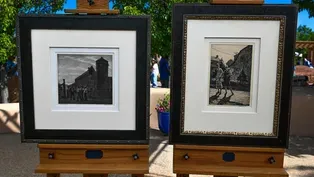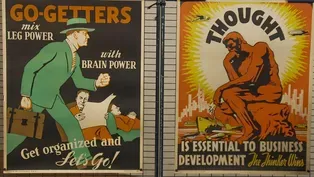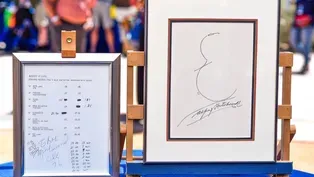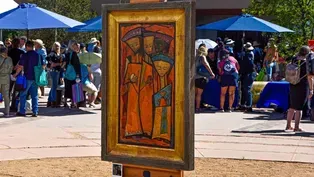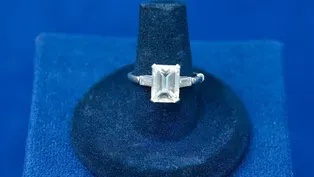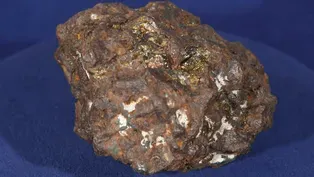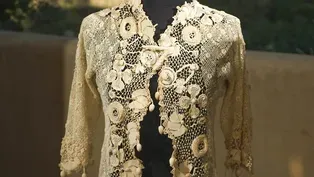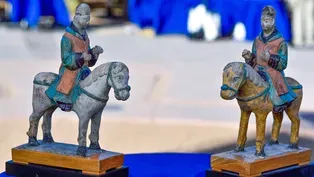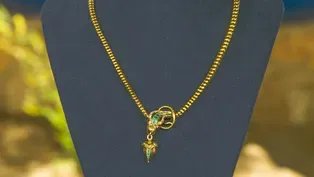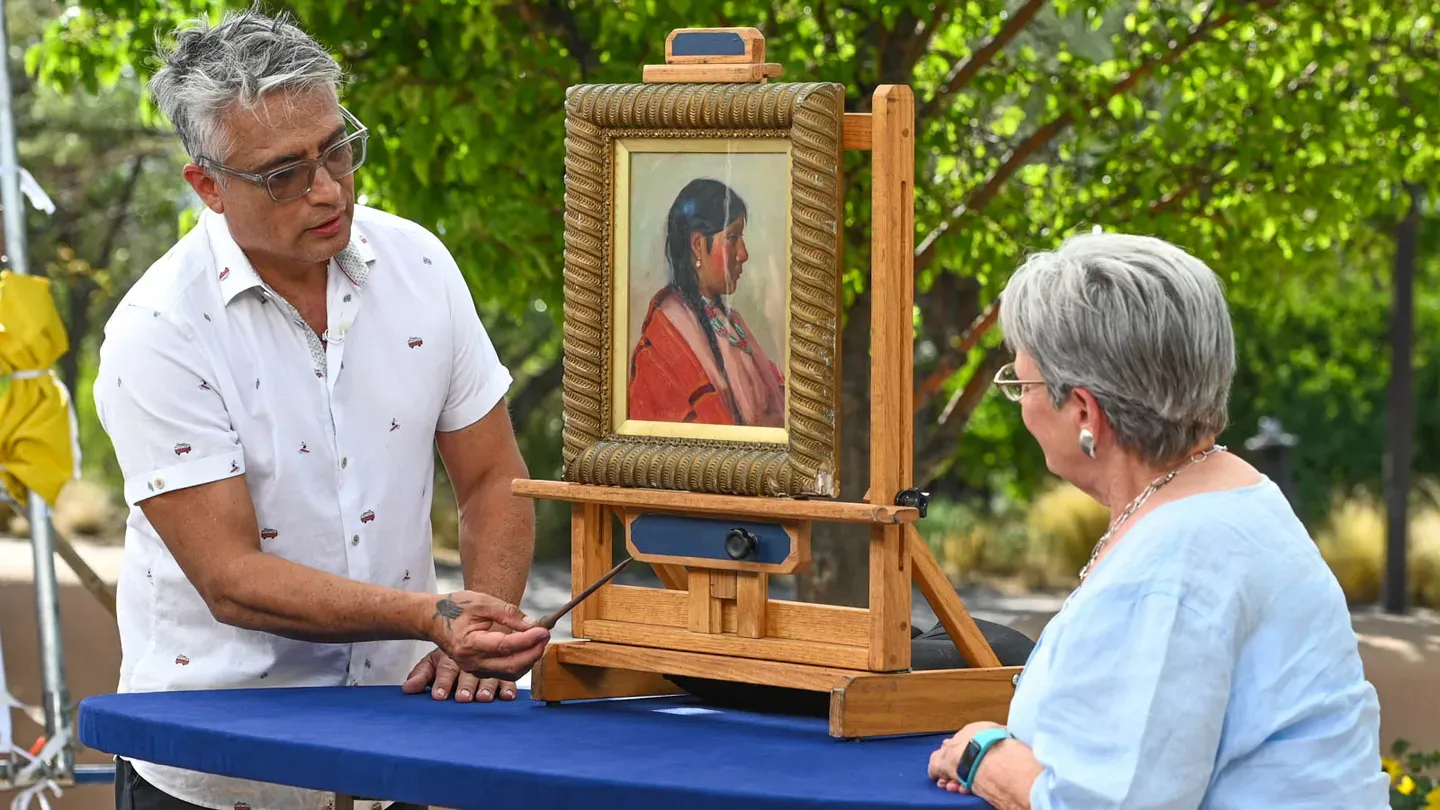

Santa Fe’s Museum Hill, Hour 2
Season 27 Episode 5 | 52m 27sVideo has Closed Captions
New ROADSHOW in New Mexico with a $250,000 appraisal and more at Santa Fe’s Museum Hill!
New ROADSHOW in New Mexico at Santa Fe’s Museum Hill, with finds that include an Ángel Botello oil painting, ca. 1960, Muhammad Ali and Alfred Hitchcock autographs, and a 1969 Alexander Calder sculpture. One is valued at $250,000!
Problems with Closed Captions? Closed Captioning Feedback
Problems with Closed Captions? Closed Captioning Feedback
Funding for ANTIQUES ROADSHOW is provided by Ancestry and American Cruise Lines. Additional funding is provided by public television viewers.

Santa Fe’s Museum Hill, Hour 2
Season 27 Episode 5 | 52m 27sVideo has Closed Captions
New ROADSHOW in New Mexico at Santa Fe’s Museum Hill, with finds that include an Ángel Botello oil painting, ca. 1960, Muhammad Ali and Alfred Hitchcock autographs, and a 1969 Alexander Calder sculpture. One is valued at $250,000!
Problems with Closed Captions? Closed Captioning Feedback
How to Watch Antiques Roadshow
Antiques Roadshow is available to stream on pbs.org and the free PBS App, available on iPhone, Apple TV, Android TV, Android smartphones, Amazon Fire TV, Amazon Fire Tablet, Roku, Samsung Smart TV, and Vizio.
Buy Now

ANTIQUES ROADSHOW 2025 Tour!
Enter now for a chance to win free tickets to ANTIQUES ROADSHOW's 2025 Tour! Plus, see which cities we're headed to!Providing Support for PBS.org
Learn Moreabout PBS online sponsorship♪ ♪ CORAL PEÑA: "Antiques Roadshow" is exploring the peaks and valleys of the art and antiques markets at Santa Fe's Museum Hill.
I really think this is one of his best pieces that I've ever seen.
Oh, my!
Oh, gosh!
(appraiser laughing) (laughs): Yow!
♪ ♪ PEÑA: For thousands of years, this area has been recognized as Oga Po'geh, White Shell Water Place, home of Pueblo Native Americans the Northern and Southern Tewa, often identified as Tanos.
Santa Fe, the oldest capital city in the United States, was founded by Spanish conquistadors between 1607 and 1610.
Centuries of the region's history and more is explored here at Museum Hill.
Today, "Roadshow" has set up between the Museum of Indian Arts and Culture and the Museum of International Folk Art.
We'll look at their collections later on, but right now, let's see what treasures have come into "Roadshow."
I have a painting that was in the Carnegie mansion in New York City.
My father-in-law worked as a boilerman for the Carnegie family while Mrs. Carnegie was still alive, but Mr. Carnegie had already passed.
And when she died, her daughter Mrs. Miller chose to get rid of certain things that she did not want.
So they put small prices on everything, hoping that the employees of the building could purchase them, not knowing that they were going to be gifted.
Wow.
So everybody picked some moderate things to, to take, and then at the end, they didn't have to pay for it, and this is one of them.
And it was in my in-laws' house since 1946, which is the year my husband was born.
And he remembers it being in the house all those years and, and loved it.
Do you know anything about the artist?
I don't.
Or do you have any idea about the, the subject matter?
No, I moved about two years ago, and it's been in storage in the house, and I had forgotten to really look at it, and was surprised that it was a woman and not a man, because that was my memory of it.
I actually looked at the back, on the verso, to see if there was any information.
But it's still, as you see, it's in its original frame.
And it has paper on the verso.
It's all sealed.
And so it's never been opened up.
So it would be hard to discern if there were more information about the work of art.
Correct.
The subject is a Native American girl, and it is probably a Taos Indian girl.
This painting was probably painted in about 1900.
The painting itself is on board.
Mm-hmm.
It's an oil painting, and it was probably done with the model.
The model would pose for the artist in Taos.
There were so many artists coming from all over the country, really good painters coming to paint the Southwest.
And there was a Taos art colony there.
You don't have a signature or anything on the painting.
We're not aware of the signature unless it's hidden behind that frame.
When I first saw it, I knew exactly who painted it.
You did-- that's amazing.
And so all I had to do was look behind the dust in this area in here.
You can see it.
"J.H.
Sharp."
(gasps) Joseph Henry Sharp, who was a very important American painter, but more so, a really important Taos painter.
Mm-hmm.
He actually came from Ohio.
He was born in 1859, and then he died much later, in 1953.
Joseph Henry Sharp was just a master of capturing still lifes, but also his subject matter.
Mm-hmm.
He painted almost exclusively in Taos, Taos Pueblo Indian people.
So these are real people.
It's a real portrait.
The fact that it's never been opened, it's never been cleaned, it is as fresh as you can get a painting.
It's in A-plus great condition.
If it were to be in a retail gallery situation, this painting would bring between $50,000 and $70,000.
(gasps) (voice breaking): I can't believe it.
(sniffles): That's amazing.
It's really wonderful.
Just amazing.
I... Look at this.
You know, I, I get these...
I wasn't ex... ...you know, goose pimples, thinking about, like, this is not... You didn't know that it was there, and...
It, it's just a wonderful, great painting.
Thank you so much, thank you so much.
It's wonderful news.
This is so unbelievable.
Yeah.
♪ ♪ This is a wall plate.
I think it's, uh, tinned copper.
Not sure.
It was my grandma's, she was a big world traveler.
Could be from, I don't know, Morocco?
India?
Tibet?
MAN: My mother used it as a sewing basket.
Possibly Mandan, because it was from North Dakota.
What?
(laughing): That's all I...
Mom knows nothing 'cause her mother died when she was very young, so... (murmurs) Okay, go northwest, and keep going.
Oh-- past Montana?
Past...?
Keep going.
Canada?
Keep going.
Alaska?
Yeah, keep going.
Really?
Oh, wow.
(laughs) Up toward the Bering Strait.
It's made out of high grass or seagrass.
Okay.
And see these little colored things here?
Mm-hmm.
That's seal gut.
That's been dyed.
Okay.
It was made to sell, but they definitely...
Okay.
...made 'em to use, as well.
Not worth a tremendous amount of money, but definitely a cultural artifact.
It's almost iconic for the people that live in that area.
WOMAN: My husband was in law enforcement, and in his spare time, kind of a passion of his was to hunt meteorites.
He passed in 2010, and so this was one of the things that he always wanted to find out more about, and to see how much it was worth.
'Cause he collected a lot of meteorites over time.
The first one he brought home was a, a little tiny one that he wasn't sure what, if it was real or not.
He used to call 'em "meteo-wrongs."
(laughs) So he would, he would go home and, and try to experiment with them to see if they were real.
His collection was large-- he had 'em from really little to, you know, pretty good size.
This was the largest one that he found.
So do you know where your husband found it?
Uh, he found it in Glorieta, New Mexico.
How far is Glorieta from Santa Fe?
About 14 miles.
The Glorieta Mountain Fall is a very famous meteorite fall.
When a meteor is heading for Earth, it starts to break apart.
Mm-hmm.
And then when it hits the ground, becomes a meteorite, it becomes something on the ground.
And it scatters quite a big field.
You can find little bits.
You can find larger specimens.
The original fall specimens were first discovered in 1884, and some large specimens were found, but that doesn't mean that many others weren't scattered throughout the area.
So you thought he found this when?
Uh, 2008.
So it's amazing that people were still finding specimens that far after the original fall.
Right.
It's what is known as a pallasite.
It's a type of a stony iron.
And that comes from the fact that there are stones and it's also, there's iron.
The little crystals we can see is olivine, and then the metal is iron and nickel.
If you took a magnet to it, it would attract a magnet.
Of all the meteorites that are found, only less than one percent are, are stony irons.
So that makes it rare.
But what makes it even rarer for the Glorieta Mountain Fall is because they range from iron, to just a few crystals, to kind of loaded with crystals.
You can see some of the crystals on the surface.
Mm-hmm.
Normally, what a collector might do is cut it into thinner sections, and then you slice it and polish it.
You would see clearly the enclosed crystals, and would be able to see through them.
And it would give these great kind of, great, greenish kind of colors.
Mm-hmm.
What's wonderful about this is that nobody's done that.
I'm 90-plus percent confident this is from the Glorieta Mountain Fall.
Mm-hmm.
To be sure, you'd have to take it to a university that has a lab that would be able to do specific, uh, tests on it.
And the reason they could do that, again, because the, the Glorieta Fall, not only is it a stony iron, but it's a rarer class of stony iron.
So it's a rare class within a rare class.
Oh, okay.
So it's, it's, uh, very well-known for that reason, because of its chemical makeup.
I can't imagine how your husband must have felt finding these things, 'cause he's out in the field, and that kind of endorphin rush you get.
Right, right.
Do you remember co, him coming home and...?
Oh, he used to tell me all the time, "This is the first time that this star has touched human hands."
Wow.
I tried to weigh it.
We didn't have an, a super-accurate scale, but I'm thinking it's around 1,300 grams.
Okay.
And as such, I would say we're looking at a value of, for insurance purposes, $20,000.
Wow.
And it's just a fabulous... Wow.
That's wonderful.
(laughing) He would have been jumping up and down right now.
He really would have.
Feel free to do it.
(laughing): Yeah, thank you.
He would have loved it.
♪ ♪ PEÑA: In an exhibit at the Museum of Indian Arts and Culture called "Painted Reflections," most of the fascinating ceramic bowls and jars on display were created during the Great Pueblo period between 900 and 1300.
Isomeric designs on the vessels create dual perspectives of positive or filled-in spaces and negative or blank spaces, and are aesthetically complex representations of balance, movement, and renewal.
You have representations here of two giant figures of the 20th century.
We have Muhammad Ali on the left and Alfred Hitchcock on the right.
How did you get these?
WOMAN: So it was a really early job for me.
I was 23 years old, and I was working for a PBS program called "Agronsky at Large."
And Martin Agronsky was something of a titan, too, in the news business.
In this program, he interviewed major figures.
So world figures like Anwar Sadat, uh, Leonard Bernstein, and Muhammad Ali and Alfred Hitchcock.
And as the production assistant, I didn't have a whole lot to do with it, except, I was in the truck and I was taking notes.
Martin would do a full interview, a half an hour, with one of these famous people, but that interview would be preceded with a short introduction.
And so the story of the introduction is the story of the Alfred Hitchcock.
The director couldn't figure out how to do the introduction.
And we were at a cocktail party, and my husband suggested, "Why don't you use the opening of "the TV show, in which you see a hand, "and the hand is drawing this caricature, and the camera pulls out to show you Alfred Hitchcock?"
So the director said, "What a great idea."
And so we were at Universal Studios, and we were on the set of the "Psycho" house, and Hitchcock was sitting in a director's chair that said "Mr. Hitchcock," and Agronsky was sitting in a director's chair that said "Mr.
Agronsky."
And the camera starts on the hand, and the hand is drawing.
And Martin was a one-take guy.
He didn't make mistakes.
So the first take was fine.
You always do a safety, right?
Second take was fine.
And the director said, "Line it up, do it again."
And I'm thinking, why?
And then he said, "Line it up, do it again, and again."
We did five takes.
And there were five of us who traveled.
And when it was over, the director handed all of us the hand-drawn, hand-signed Alfred Hitchcock caricature.
So he, he pulled a fast one on Hitchcock, and he got him to keep repeating the take and made him think that they needed more takes.
And so your job was kind of keeping the time codes.
Right.
And that's where this sheet comes in.
Exactly.
So this is a show rundown.
And it shows you the individual times.
My husband, then my boyfriend, said, "Please don't come home without an autograph from Muhammad Ali."
And I didn't really have anything to give him to sign.
And so I gave him the rundown.
And he wrote, "To Bob, Muhammad Ali, '76."
(murmurs) This one was November of '76.
This one was May of '77.
So when, when did the Agronsky show run?
I don't remember the exact dates, but it was only 26 weeks, and I think it was once a week, and it was in '76 and '77.
So we're keeping it in the PBS family today.
(chuckling): Keeping it in the PBS family.
You're-- welcome back to the PBS family.
One of the things that we talk about when we talk about autographs, there, there are hierarchies... Of course.
...and the values change based upon what has autographed.
Hitchcock is known for this caricature.
So we, when you have an Alfred Hitchcock autograph, to have it with the caricature is obviously much better than just his name on a piece of paper.
Sure, mm-hmm.
But even once we get to that point, we also look at, how big is it?
Right.
Because he often would sign sheets for people and he would do his caricature, but it, it might be two by three inches, something in an autograph book.
Then you get into something slightly larger, and we're in a different ballpark.
If you were to guess which is more...
I would guess this one.
You would be right.
There's a really big difference between these two.
Really?
Ali is a giant of the 20th century.
However, he signed a lot.
A lot, a lot, a lot.
So at auction, the Muhammad Ali would sell for about $200 to $300.
Because you have such a big Hitchcock-- it's on a nine-by-12-inch sheet... A similar one on a big sheet, but he only made the caricature very small in the center of it, sold for about $2,000 to $3,000.
Huh.
The most recent one that used the full sheet, like yours, and I've only ever seen one, sold for $11,000.
(chuckling): Wow.
So if they were, if it were to go into an auction, they would probably put an estimate of about $6,000 to $8,000 in hopes of achieving a nice result like that again.
But that is what a huge difference the size makes.
Hm, it's kind of amazing.
I actually wondered if the one that sold in 2019 was one of the other five.
Wow.
It would explain why it was so big and it's exactly like yours.
This is our Great-Aunt Lillian.
Her fiancé died and she never got married.
WOMAN: But she traveled the world because she was liberated since her fiancé died.
And there's pictures of her in Egypt and all over riding camels.
Wow.
I know!
And then she died young.
And her hair is in the locket.
APPRAISER: We see it's diamonds on the front.
Did you know that this is actually a watch case?
WOMAN 2: No.
It would have been a lapel watch case.
It would have hung down from here on a pin.
Oh.
It would have hung on your chest.
And where the picture is now was a watch crystal.
Oh.
And the dead-tail giveaway is the hole at the bottom.
There would have been a stem and a crown.
Oh.
Oh, right, right, to wind it.
So this was a very fancy deco dress watch.
And then you guys, or Aunt Lily... Or someone in the family.
Aunt Lily-- Great-Aunt Lily.
Somebody-- you switched it.
Then you didn't stop there.
You got a chain with... More diamonds.
More diamonds.
With more diamonds.
Of course.
Of course.
Our family does diamonds.
At auction, this would be $2,000 to $3,000.
Wow.
That's unbelievable.
I think it's almost cooler as a locket.
Oh, yeah.
Than a watch.
Mm-hmm.
I brought here a painting that was in the family by Ángel Botello.
I think the first photo that I noticed with this painting was about a year after I was born.
So at least '62.
We had already moved to Puerto Rico, and this was hanging on our wall.
My parents and him and his wife, Christiane Botello, were dear friends.
We would hang out on weekends together, and I became very close to his children.
He had three children.
When we moved back to Washington, D.C., he came along and rented a house behind ours and stayed the summer with us just so we could all hang out still.
And so we'd been friends forever.
I'm still friends with his kids.
What do you remember about the artist, about the man, really?
Oh, my gosh.
He was larger than life.
I mean, and he was a big kid.
So when he had passed, it was just devastating to everybody.
He had a huge sense of humor.
He was sorely missed.
And, and you brought a picture with, uh, with you, right?
Yeah, this is myself and Ángel Botello when he visited us in D.C. Uh-huh.
And in fact, behind it is another painting that we have of his.
Okay.
He just would make things and then drop it off.
This one, because of its colors, was always a personal favorite.
Well, let's talk a little bit about, about the artist.
He was born in Spain in 1913.
Then he did go to France with his family in the 1920s.
And when he was in France, he studied architecture until 1935 or so.
And then he, uh, fought in the Spanish Civil War.
After the Spanish Civil War, he started traveling, and he came to the Caribbean.
He was in Santo Domingo and then in Haiti.
He loved Haiti.
He became famous during that time, especially for his Haitian scenes.
Eventually, he settled in Puerto Rico, but this was around 1953.
He was already well-known, and he opened a gallery at the Caribe Hilton there.
In Europe, he saw so much Fauvism, Post-Impressionism.
So he's almost like a Spanish Colonial painter.
He paints from a perspective not of a colonialist, but as part of the society.
So when we look at this, what does this depict, for example?
This is the Three Kings, the Virgin Mary, and Christ Child.
And a lot of Spanish Colonial painting is based on religious themes.
Yes.
The angular style was, uh, something that he was very famous for.
These triangular faces and the very dark, mottled figures.
And he was also, again, very famous for the colors because he loved the Caribbean.
He fell in love with the colors there.
If you look at the figures, some of them could be Puerto Rican, some of them could be Haitian.
I think it's because he wanted people to understand and relate.
When you look at a lot of Colonial art, it almost seems like sometimes an imposition.
But here it's a celebration of where he is.
He painted a lot of single figures, a lot of women.
He was famous for that.
These kind of paintings with multiple figures, he didn't do a lot.
And I really think this is one of his best pieces that I've ever seen.
It is oil on wooden panel, and the frame is probably his, as well.
Yes.
This is another aspect to his artwork.
He celebrated rustic work, artisanry, and local traditions.
I don't see a title on the back.
Yeah.
And I don't see a title anywhere else, nor a date.
But we established that the date was probably early '60s.
Yeah.
Have you ever thought to get it appraised or have you ever had it appraised?
No.
Well, he died in 1986 from lung cancer... Yeah.
...because he was a lifelong smoker.
Yes.
And his prices were pretty stable for a while.
And then in the last five to ten years, they've gone up a lot.
And again, because so many of his works do not have multiple figures and are not this grand, this artwork, if you were going to insure it, I would insure it for $100,000.
(laughs quietly) Thank you.
(laughs) Thank you.
I didn't think it was that much.
PEÑA: The Museum of Indian Arts and Culture has an incredible jar created by Maria and Julian Martinez around 1920 at San Ildefonso Pueblo.
It was an innovation in 20th-century Pueblo pottery, combining matte black painting with polished black surfaces.
In fact, this rare piece was from their first firing of a matte-on-black design.
The figure represented is a Tewa feathered water serpent, Avanyu.
♪ ♪ I first became familiar with Martin Lewis, the artist, probably 15 years ago.
I went to an exhibit of prints at the Bruce Museum in Greenwich, Connecticut, and there was a whole line of these.
I went to the spring print sales in New York in 2014, and here they were on the wall for sale.
And I recognized the farmers over here.
And I think he was good friends with Norman Rockwell.
And I'm pretty sure that this is a portrait of a young Rockwell and his wife and baby at their garden.
This was a lot of two that sold for about $6,000.
Martin Lewis, the artist, he was Au, Australian-born, and he came over to the U.S. in the early 1900s.
Finally settled in New York, and like so many of his peers, he found work as a commercial illustrator in order to make ends meet.
And it wasn't until the 1920s or so that he was successfully selling prints and could leave the world of commercial illustration.
He was friends with many other New York illustrators at the time.
He taught Edward Hopper to make etchings.
Okay.
In the early 1920s, he'd actually, took a two-year sojourn and went to Japan to hone his skill as an artist and learn different techniques.
And he comes back and really gets into etchings.
And you have, both of these are etchings.
The one closest to you is called "Sunday Garden Inspection."
And he did that in 1927, and he only made about 30 impressions of that print.
There's no documentation saying that that's Norman Rockwell that I found.
Yeah.
But I agree with you, it does look like him.
(chuckles) That is a suburban scene probably done on the New Jersey side, near New York.
He was doing scenes like this in and around Weehawken, New Jersey, just across the Hudson River.
And he's much better known for his dark, gritty New York urban scenes.
Those are the, those are the etchings that everybody tends to know about Lewis.
In 1932, because the Depression was having such an adverse effect on artists in New York, on the advice of his friend and fellow printmaker Armin Landeck, Lewis moved out of New York to Southern Connecticut in search of a lower cost of living.
They worked in Connecticut for several years.
And this scene closest to me, called "Politics," from 1936, is actually a scene from Connecticut.
It shows the men standing around the barn discussing politics.
In both cases, you see Martin Lewis's use of that chiaroscuro, or the play of light and dark, and he's so well-known for that in his prints.
It, it raises the dramatic quality of his prints.
And both of these etchings show off his skill as a meticulous printmaker.
They're both signed by the artist in pencil, lower right.
This one closest to me is actually a trial proof.
He made 11 trial proofs of this subject.
In each of the trial proofs, he would slightly alter the etching.
You have the second one of 11.
Once the edition was decided by Lewis, only 16 got printed.
So extremely scarce.
Mm-hmm.
Now, they're both in great shape.
They're in museum-quality mats.
The etching closest to you, the "Sunday Garden Inspection," I would put an auction estimate on that at $5,000 to $8,000.
Mmm.
For a replacement value, I would put $10,000 on it.
Okay.
The one nearer me, "Politics," which is the more desirable print, I would estimate an auction estimate at $8,000 to $12,000.
Oh, really?
Okay.
An insurance value, I would put a value on that of $20,000.
Really?
Okay.
Good $6,000 investment.
(laughing) Thank you.
♪ ♪ It's a Norman Rockwell artist's print and it's signed by Norman Rockwell.
I bought it at an auction.
I paid three and a quarter for it.
I think the original hung in, uh, the White House for a period of time during the Obama administration.
And this young lady now is grown, and she was there for the installation in the White House.
So I thought it was pretty interesting.
MAN: I picked it up at an antique store.
He was enrolled in '62 as an infantryman in a little town about five miles south of the Canadian border.
And he went through all the major East Coast battles, and we, went from an infantryman to a brevet captain by the end of the war-- he made it in one piece.
(chuckling) This is one of the fancier memorials we see out there.
The printed, mass-produced examples usually bring in the $150 to $250 range.
Now they've gone down a bit.
Mm-hmm.
The fancier ones now are in the $200 to $400, $300 to $500 range.
What'd you pay for it?
$45.
Okay, there's a win.
(laughing) All right.
There's a win.
APPRAISER (chuckling): You've brought a, a number of Georgia O'Keeffe items signed.
What's your connection?
Well, when I was young and crazy, I was invited to work for her for a while as a cook.
But she rapidly discovered that I was a terrible cook so she fired me.
This little Indian pudding recipe is a result of that short time that I was cooking for her.
After a while, she called me up and said, "Well, you can't cook, you don't clean very well, but can you type letters?"
And I said, "Yeah, I can type letters."
She hired me to stay up in Abiquiú, and type letters for her, read to her.
She was just losing her eyesight at that time.
We had a very nice time together.
I stayed up there for a couple of years.
One evening, we were sitting in her studio, the ceiling was painted white, the walls were painted white.
She said, "You know, I wish I had a white floor."
And I said, "Well, why don't you get a white rug?"
She said, "Well, I can't get a white rug.
If I get a white rug, it'll get dirty."
And I said, "Oh, Georgia, you're richer than God.
"Get a white rug.
And when it gets dirty, tear it out and put a new one in."
(laughs) So she kind of laughed at that, but she said, "It would be wonderful, because if I had a white rug "and we were sitting here, it would be like sitting inside one of my cloud paintings."
I stopped working for her after a certain amount of time, and she got the white rug.
She mentions it in the book, and she mentions it here.
She says, "The white carpet is getting dirty now, but not too bad yet, though."
Did she talk about her artwork at all?
She did not, and she never talked about her past.
The book itself shows up everywhere.
It's, it's not a rare book, but of course, if you open it up and have a nice long inscription in it from 1978... And would she just keep in touch or send you things, or...?
Yes, she did for a while.
When I left, she said, "Well, who's going to help me now with my secretarial stuff?"
I said, "Well, my mom lives in Santa Fe.
She can help you."
My mom came up, and they got along really well.
And it was when my mom was working for her that this book was created.
They put this book together, and my mom did the essential editing.
One of the other things that I'll point out, in the letter nearest you... Mm-hmm.
...she actually mentions Stieglitz, she mentions Henry Miller.
Not necessarily all that favorably, but... (laughing) But, but it is there, which is... Yeah.
If you have a letter by Georgia O'Keeffe typed, with her handwriting, mentioning people who are known, prominent, and so on, is important.
One of the things, though, that I liked very much is the cooking aspect of everything.
(chuckles) To have a recipe of hers.
I think if anything, in this grouping, individually, people would get almost more excited about that.
Yeah.
It continues on the back.
And you could make her Indian pudding.
The Georgia O'Keeffe book, I would say, would be about $750 because of the inscription.
The two letters, one letter is better content-wise because it has, says more, but it's typed.
One letter is handwritten, which is better.
Each of those, probably about $500, each.
Good heavens.
The recipe, people love cooking.
(laughing) And just the idea of having a recipe of Georgia O'Keeffe that she wrote out, easily $750, maybe more.
(chuckling) And this is all on a retail level.
Right.
And I think the thing that would really be the attraction that if things were going to go higher, is the, the short little recipe.
(chuckles): Oh, absolutely.
I'm going to try to make it someday.
(both laughing) Or maybe you could have someone make it for you so you'd know what it would ta, ta, taste like.
(laughing): That's, that's a better idea.
A much better idea-- maybe my husband can.
He's a good cook.
WOMAN: The ring belonged to my grandmother, who was born in, I think, 1895?
I really don't know much about it.
I did not know her very well.
I only met her a couple of times during my life, and the ring came to my mother, and my mother wore it quite a bit.
My mother never told me anything about it, so I just wear it.
Never had it appraised.
I was afraid that it might just be a piece of glass.
But... (laughs): Okay.
So I thought, "Well, I'll bring it."
Mm-hmm.
"Let's see what it is."
And what do you like about this piece?
Well, it's big.
I like big jewelry, and this looks, uh, kind of a little ostentatious, so that's okay.
(laughs) Well, it's a, it's a beautiful ring.
This is an early Art Deco piece from the 1920s.
We have a emerald-cut diamond on the center.
The clarity of the stone is an SI1, which is slightly included.
And the color is H in color, so it's near-colorless.
And if you could estimate the size of that stone, what would you estimate it to be?
Two carats?
Well, it's a little larger.
It's actually 3.30 carats, so it's a little bit under three-and-a-half carats.
Okay.
And then you have two accent baguettes.
Uh-huh.
And they're straight baguettes.
Usually, you'll see pieces with tapered baguettes.
This, these are straight, and they're channel-set, or half-channel.
Oh.
That's what the bars are called in between each diamond.
Those measure about 15 points each.
So all together, you have about 3.60 carats.
So a little bit over three-and-a-half carats.
Oh, a little over three-and-a-half, okay.
All together.
We don't have a way of knowing the maker, because there's no hallmarks or maker's marks.
The inside of the ring is marked platinum, which helps me identify that it was made in the U.S., likely in New York City.
If this was to be offered at auction, I would estimate a value of $20,000 to $25,000.
Oh, wow, oh, my!
Oh, gosh.
(laughs) Yow.
Whoa!
I didn't... (laughs): Are you okay?
Oh, that's a lot.
Yes, it's, it's... Oh!
The design, it transcends ages, because you still see this style being sold nowadays.
It's a very popular style.
Oh.
It's this really timeless piece.
Oh, oh, gee, that's great.
Now... (laughs) I would expect an insurance, uh, estimate of about $50,000.
If you had to go out and replace it... (gasps): Oh, my God.
...I would expect to see that for insurance purposes.
Oh, my God.
Okay.
(chuckles) That's more money than I ever thought.
♪ ♪ WOMAN: My dog received the Dog of the Year Award in 1952.
I was kidnapped, I was two years old.
I was playing in my yard, and my mom came out to shake him up, and there was a man running down the street with me.
She said, "Skippy, go get Linda."
He jumped the fence, bit the man, and the man threw me off and ran away.
So they sent us to the Waldorf Astoria in New York, had a big Dog of the Year banquet, and they fed my dog on a porcelain plate, a steak dinner.
So this was his award that they gave him?
That was the award.
And this was always hanging in our house.
It is absolutely worthless object...
Yes.
...if it were sold to someone... (laughs) ...who didn't know the story-- it's chipped, it's cracked, it's stained.
Yeah.
But it's priceless to you and your family.
Yes.
And that's the point.
That's the value, yes.
Yes.
WOMAN: My dad's grandmother traveled to China in the 1920s.
She came back with these horses, and my grandparents had these cases built for them.
When my grandparents passed away, my dad and my mom moved into the house, and they raised my brother and I in that same house.
So they've just been displayed in that house in the living room...
Forever.
(laughs) So, these...
These are a part of your family.
Yeah.
They're actually one of the earliest examples of mass production.
Oh.
These are tomb figures.
Your tomb would be, in a way, a house, and you would be surrounded by objects.
Okay, yeah, okay.
So that when you passed, you could bring things with you into the new life.
Gotcha, okay.
And if you were a wealthy individual, you wanted to have the ability to have a similar lifestyle after you passed.
Oh, yeah.
So you brought with you the trappings of a wealthy life-- attendants, soldiers to protect you, farm animals, all kinds of things, and some beautiful horse figures.
These are earthenware figures, and they were produced in molds.
They made hundreds of these at a time, thousands at a time.
Okay.
I believe that they used sand molds...
Okay.
...in order to cast them.
This type of a glaze is called fahua.
Fahua was invented in the Yuan Dynasty and into the Ming Dynasty.
And these figures, I think, date to the early Ming Dynasty.
Wow.
14th or 15th century.
Whoa!
Number one, the color is the clearest indication.
This was a period in the Ming Dynasty, 1368 to 1644, that fahua was really popular.
And then it kind of died out.
Okay.
It was no longer really used.
Another thing, the shape.
You have horse figures, but each period, they look different.
Okay.
And during the Ming Dynasty, they're a little bit more robust.
Oh.
They're thicker.
And when your grandmother got them.
If you had said, "My father was in China in the 1970s," would've been more doubtful.
But 1920s, absolutely.
It makes sense-- Shanghai was booming.
People were buying things up, bringing them back to the West.
Okay.
The Qing Dynasty had just fallen, 1912, and it was really an, a wild time of growth in China.
And suddenly there was a demand for something that had never previously existed, because Chinese people did not want those in their home because they're from a tomb.
So there's the association...
Right.
"I don't want ghosts haunting."
When these were brought out in the early 20th century and late 19th century, there was a bit of a power gap.
The Qing Dynasty was ending, and it became easier for something to take place that maybe the government would not want to take place, which was tomb robbery.
So, non-authorized digging of tombs.
Right, right.
There were authorized digs that were taking place.
I don't know where these came from.
Yeah.
(laughs) We can't... We can't find that out.
Ooh.
We don't know.
Yeah, yeah, yeah, yeah.
They're in good shape.
We do have some restoration, here on the front leg of this fellow.
Okay.
The back leg, the yellows.
Tombware figures are not really desirable in China today, because they are... Just because of the history?
Because of the history.
Okay.
But in the West, they are still desirable.
If they were to come to auction today-- as the two, as the set-- they would bring around $800 to $1,200.
No!
(laughs) You're kidding.
Okay, cool.
(laughs) Do you want 'em?
(laughing): Just kidding.
My dad won't let go of 'em.
(laughs) Come get 'em!
(laughs) ♪ ♪ PEÑA: Every piece on display at the Museum of International Folk Art is intriguing, but this one commands, "Look at me."
The 2006 work by Kono Junya depicts a supernatural entity in Japanese folklore: Ao Bozu, blue monk.
There are many frightening stories about Ao Bozu, but he is said to resemble a priest and have a strong connection to magic.
WOMAN: I got that from my grandmother.
I understand she was from the U.K. APPRAISER: Any idea of how old it is?
I'm guessing it's maybe a turn of a century or someplace around there.
It's a serpent necklace.
The symbolism of this piece is one of love.
It hearkens back to the Greek images of Aphrodite with her companion serpent entwined, and it suspends a heart.
Queen Victoria got married in 1840.
Mm-hmm.
And she wore as her engagement ring a serpent ring from Albert set with an emerald.
And what we have here is a love token, a love necklace, from 1840s through the 1850s, give or take.
It is gold, I tested it.
Mm-hmm.
It was higher than 14 and lower than 18.
Cool.
And 15-karat is an English assay, so... Oh.
...all the pieces fit.
Yeah, they do.
It's a graduated, highly flexible serpentine chain made of separate links.
It's set in the head with emeralds and diamonds.
The eyes are rubies.
Now, suspending from the serpent's mouth is a heart.
And if I turn the piece over, you'll see, on the back of the heart... Mm-hmm.
...you'll see a little chamber.
And it might be foggy.
Yes, I was wondering what that was.
There's an oval panel of hair that's been woven into a fabric like the finest silk.
Oh.
And that is the hair of the loved one of the wearer of this necklace.
Wow.
Had no idea.
Serpents were a, a symbol of love and a, a symbol of wisdom, as well.
Very popular in the Victorian era.
This is a nice early example.
It's in perfect condition.
Good.
In a retail setting, this necklace would bring $8,000 to $10,000.
(gasps) Oh, really?
Yeah.
It's a really nice one.
Oh, well, thank you.
WOMAN: I brought in these antique posters, which I believe to be from the Great Depression.
I guess the story behind them is that my father, his father, he owned this store in Plainfield, New Jersey, and I guess he collected them and he put them in an attic.
My grandfather was known for wrapping everything in a little bow.
My dad, when he went to go visit a few years ago, he went up there and he found these.
He brought them back to Santa Fe and he gave them to me, and now I'm here.
They're, first and foremost, very colorful.
(chuckling): Yeah.
These posters are all from 1935.
Yes.
And what they are is a genre of posters that are called work incentive posters.
This is a tradition of posters that began in the 1920s with a company called Charles Mather.
These were printed in Chicago by the Sheldon-Claire Company.
The historical record says the company began in the 1930s.
Nobody really knows when they began.
Their work became very prominent during the Second World War, when they worked for the government.
So these posters from 1935 are the earliest posters from this company that we've seen, and helps actually give us some knowledge as to when the company was founded.
And this is a series of posters that were aimed for traveling salesmen or for salesmen.
Mm.
And so each one of these is instilled with an image that would have gone up in businesses to impress upon their salesmen how they could be better salesmen.
And I think the first one that says it the best is this one: "Doorknobs!"
(laughs) Like, what?
A poster about doorknobs?
But they're basically saying, "Turn more and you'll sell more."
The more people you see, the more businesses you go in to visit, the more money you'll earn.
Mm-hmm.
The one next to you: "Winning an argument may lose a sale."
If you argue for the sake of argument, you may lose the sale.
So it's basically telling the salesmen, "Don't argue, just get out there and sell."
"Go-getters mix leg power with brain power.
Get organized, let's go."
And that image is great, because it shows the salesman.
He's all ready to go.
He's got his fist clenched and sort of laying down are these lazy, do-nothing salesmen.
My favorite of all of these is this one, with an image of Rodin's "Thinker."
"Thought is essential to business development.
The thinker wins."
And this is a great image.
It's got Zeppelins and airplanes, cityscapes in the background, these wonderful Art Deco representations of modes of transportation.
How many of these do you have in total?
I have about 40, but the other ones are pretty, um, mangled and kind of distressed.
As I counted, in total, you brought 17 with you today.
I brought 17 with me today, yes.
The way these were used is, they were distributed on a weekly basis.
Mm.
And some of them have numbers on the bottom.
So, for example, number ten, and you see number 31 there and number 16, those would have been the weeks.
So there would have been 52 of these in the series, one for every week in the year.
Oh, wow.
It's really interesting to me that they're all men in the posters.
There's no women, there's no feminism.
It's all just "manly man, go, go, go."
Like it or not, back then, the workforce was mostly men.
That is a snapshot of the 1930s American working class.
Oh, yeah.
What do you think these are worth?
I think, in total, like, the whole collection is worth about $500.
One of the things a salesman would be told is that the customer is always right.
Yeah.
So it would behoove me to tell you that you're right.
Oh.
But it's my job as an appraiser to tell you you're wrong.
Oh!
(chuckles) That's not what they're worth.
In fact, they're worth almost that much each.
Each?
At auction, I would estimate these between $400 and $600 each.
(laughing): Wow.
I, I did not ev...
I couldn't even imagine that.
And so for the 17 that you brought in, the total for that is between $6,800 and $10,200.
(laughs) For those 17.
Wow, that's crazy.
I'm shocked, actually.
I've never seen these images before.
(laughs) So as far as I'm concerned, these are a particularly rare set of posters.
So if the price were to go up a little bit, it wouldn't surprise me.
MAN: I actually wore these things a long, long time ago, back in the disco era.
They belonged to a friend of mine, and we swapped shoes one night.
I never got my shoes back, and he never got his shoes back.
WOMAN: My husband's uncle and my husband's father were from Greece, or their family was, and they used to go back regularly and bring things back.
APPRAISER: It was made probably in the 1920s, 1930s, but it's not Greek.
It was made in either France or Belgium.
It's what's called a Jacquard loom tapestry.
It's one of the earliest forms of mechanized loom weaving.
And it was able to create these tapestries that basically look handwoven.
Generally, a piece like this, in this condition, because you also have some condition issues.
BOTH: Hm.
You have all of that loss and staining and foxing.
WOMAN 2: Right, mm-hmm.
So in this condition, it's probably only in about the $25 to $35 range.
Okay.
In terms of bare market value.
Okay.
(laughs): Okay.
Do you use it?
Do you have it hanging?
It's, it's hanging... Yeah, it's, it's up in my house, yeah.
Good.
It's wonderful to have something that you like and use that's not tremendously valuable, because you don't have to be afraid of it.
(both talking indistinctly) WOMAN 2 (laughing): Yeah, exactly.
(talking indistinctly) WOMAN: As far as I know, it's tatted silk Irish lace.
And from the shape and design of it, I would say it's Victorian.
I found it in a house that was going to be destroyed.
The destruction crew said, "You can have anything you find here."
So I took it.
Wow.
And I've had it since 1972, about.
This is an Irish lace coat.
They are made in Ireland, obviously.
I've never seen one that was credited with who did all the work to make this beautiful piece.
Possibly they were made by women at home in their spare time, if there was such a thing.
They're very desirable because of how beautiful they are.
It's cotton, not silk.
Okay.
It's got a lot of motifs that are very typical of the Irish crochet.
Irish motifs, right.
And it's got all these brides with the little bumps, they always have that.
And then the finer work through the body.
But the very glamorous...
Right.
...and eye-catching work is on the edge and on the ends of the sleeves...
Right.
...with the bobbles, which is very desirable.
Not every piece of Irish lace is going to come with the bobbles.
And it has a beautiful scalloped hem.
And when we turn it around, we see that it has the same large motif down the center of the back.
Right.
It dates to about 1908 or 1910.
So it's not quite as old as you thought it was.
Right, yeah.
But it would have been worn with an Edwardian dress or a blouse and a skirt.
Right.
And this would have been shorter than the skirt and just looked very dramatic over it.
Right.
Originally, it was white, and you can hand-launder it and bring it back to that white, because it's cotton.
The condition is amazing.
Yes.
It's really, really in great condition, and it has something I've never seen before.
Two Irish crochet pins.
Right, for holding it onto your dressers.
To fasten it, yeah.
Absolutely beautiful.
It's really, it's a lovely piece.
I would put a retail value on this of $2,500 to $3,000.
Wow, yeah.
Thank you.
(laughs) You're welcome.
It's really been, uh, just a beautiful thing in my life for so long.
The family came into possession of this painting in 1963, when my grandparents had traded a property, and this property had belonged to Grace and Victor Bachechi.
And the Bachechi name is big in Albuquerque, because the Bachechi family built an Art Deco theater called the KiMo Theater.
Von Hassler was the main muralist there, and we want to know if this is a Von Hassler.
Hassler.
That's the family rumor, and we just want to know if somebody knows the truth.
Or we'll never know.
(laughs) MAN: I brought in a sign that we purchased at auction.
(laughing): We paid $300 for it.
Do you have any idea what it relates to?
The logo looks like a Santa Fe Railroad logo.
I'm not sure.
It's a mystery.
Well, you are exactly right.
This is an advertising piece for the Santa Fe Railroad system.
It's going to date around 1950 to about 1960.
It's highly collectible, and it's very, very rare.
When you purchased it for $300, did you think you were getting a deal, or were you spending a lot of money?
I thought I was spending a lot of money.
(laughing) Okay.
Well, I am happy to report that conservatively at auction today, we feel the sign would easily be in the $2,000 to $3,000 range.
(laughing): Amazing.
Well, thank you, Travis.
Thank you for bringing it in today.
It's awesome.
Great.
(laughing) MAN: When I was 14, I traveled to Europe with my parents.
We stopped to visit a friend of my father from after the war, south of Paris.
And it turns out his friend was married to the daughter of Alexander Calder.
And so we stayed in the compound where Alexander, who calls himself Sandy Calder, lived.
Mm-hmm.
And I was a 14-year-old boy getting around, and I happened upon his studio, and peeked in and watched him working.
He had Parkinson at the time, but when he worked, his hand would be still.
I had my 15th birthday while we were there.
Uh-huh.
And that was in, uh, July of 1969.
And he presented me this sculpture as my 15th birthday present.
I saw him working in his shop on something similar to this.
Uh-huh.
And when he presented this to me, it occurred to me that he may have actually been making it at the time.
Uh-huh.
And what did he say?
He didn't say much.
He wasn't a very talkative person, but he was very humorous.
Uh-huh.
My mother came in with some nesting baskets she had bought at the market, and he said, "Well, maybe they'll get small enough and just disappear."
(both chuckle) And tell me about his studio, what did it look like?
An old French farmhouse.
Mm-hmm.
Kind of, like, not even a farm, more of a barn.
And there were, like, pieces of metal and wire...
Pieces of metal and wire.
All, all over, and he'd wander around and pick up something.
And mock-ups, some bigger pieces under construction.
He would make small versions and then make larger, uh, versions.
I don't know if this one has a larger counterpart somewhere.
I don't know.
Calder is one of America's leading sculptors of the 20th century.
His father was a very prominent sculptor.
He was an academic sculptor.
Oh, I didn't know that.
His name was Alexander Stirling Calder.
But Calder started out as an engineering student.
He was born in 1898.
He was an engineering student at Stevens Institute of Technology in New Jersey.
He was interested in mechanics and engineering.
And you can see how that became part of the artwork that he started to do.
And he studied at the Art Students League, and he actually went to Paris in the late 1920s, stayed there for the early 1930s.
And he was part of a whole group of American expatriate artists who were living there.
One of the most wonderful things he did, he built a circus out of wire and cloth and wood, and he would have all his friends come, and he would perform the circus acts.
Oh, my gosh.
And his work starts with these smaller things, the maquettes, and there are things that, 20, 30 feet high.
There are a lot of things that hang from the ceiling and move all the time.
This is wonderful, because you have the base and this amazingly balanced piece.
Maybe you could show us how it's balanced.
And that's it.
And what, is there a little indentation there?
Just a little hole in the... Uh-huh.
And it sits right there-- it's wonderful.
The amount of movement it has is just extraordinary.
Would you call this a mobile or a stabile or a mixture?
It's both.
So this part is a stabile and this part is a mobile.
So you have the best of both worlds, is what it comes down to.
(both chuckle) They're all handmade.
You can actually see and envision him cutting it out of a piece of tin, and then they're painted.
There's a great craftsmanship.
It's signed, so it has his monogram on the side that's been pressed in.
Did you ever have it valued?
No.
I've never heard of better provenance on something artistic than what you've given us.
But it still has to be submitted to the Alexander Calder Foundation.
They authenticate pieces.
As you can see, these are relatively easy to make, so they're very easy to be faked.
It's almost impossible to sell them without the certificate.
You'd be able to present the documentation to the insurance company.
You'd have the documentation in case there was any kind of issue.
That's the gold standard.
This could be a maquette for a very large piece.
It would require research to find out if there is a larger version.
You might find that information from the Calder Foundation itself.
They have scrupulous records of all of his work.
They're fairly rare in, especially in this size.
In a gallery setting, this would be $250,000.
Wow.
Jeez, that's amazing.
I mean, it's probably worth more than that to me, just in memories, but that's...
Spectacular.
Yeah.
PEÑA: And now it's time for the "Roadshow" Feedback Booth.
I brought these Tiffany Studios candlesticks.
Um, she said they were worth between $600 and eight hun, $800 apiece, but would be about double that if somebody in the past did not lacquer them.
So, lesson there: don't lacquer your bronzes.
Today I brought this scroll.
My grandmother got it in 1973 and it came with a certificate that says it's hundreds of years old by the famous Kano, who, famous scroll maker.
And it is none of those things.
We have this santo here that's from the 1800s.
And he's missing his arm and a little crown, but he's worth about $1,500.
This is a, a rug under a chair.
We learned that it's worth about $1,500.
And you don't have a national treasure, sir.
We don't have a national treasure.
I brought with me a Picasso lithograph from 1924.
It was one in a number of series and my godmother gave it to me, actually, about 20 years ago.
Um, had it appraised then, and it's tripled in value.
So I'm quite pleased and might be going on a few vacations after I sell it.
(both laugh) For sure.
We think there should be a, a clarinetist that walks around the grounds and plays the theme for the "Antique Roadshow," uh, maybe a Dixieland band.
But definitely at least a clarinetist should be wandering around out here.
Thanks very much, "Antiques Roadshow."
Can you say thanks to "Antiques Roadshow"?
Thanks, "Antiques Roadshow."
Okay, see you next time.
PEÑA: Thanks for watching.
See you next time on "Antiques Roadshow."
Appraisal: 1927 & 1936 Martin Lewis Etchings
Video has Closed Captions
Appraisal: 1927 & 1936 Martin Lewis Etchings (3m 54s)
Appraisal: 1935 Sheldon-Claire Co. Work Incentive Posters
Video has Closed Captions
Appraisal: 1935 Sheldon-Claire Co. Work Incentive Posters (4m 2s)
Appraisal: Ali Signature & Hitchcock-signed Caricature
Video has Closed Captions
Appraisal: 1976 Muhammed Ali Signature & 1977 Alfred Hitchcock-signed Caricature (4m 13s)
Appraisal: Ángel Botello Oil Painting, ca. 1960
Video has Closed Captions
Appraisal: Ángel Botello Oil Painting, ca. 1960 (3m 56s)
Appraisal: Art Deco Diamond & Platinum Ring, ca. 1920
Video has Closed Captions
Appraisal: Art Deco Diamond & Platinum Ring, ca. 1920 (2m 39s)
Appraisal: Glorieta Mountain Pallasite Meteorite
Video has Closed Captions
Appraisal: Glorieta Mountain Pallasite Meteorite (3m 29s)
Appraisal: Irish Lace Coat, ca. 1910
Video has Closed Captions
Appraisal: Irish Lace Coat, ca. 1910 (2m 32s)
Appraisal: Joseph Henry Sharp Oil Portrait, ca. 1900
Video has Closed Captions
Appraisal: Joseph Henry Sharp Oil Portrait, ca. 1900 (3m 27s)
Appraisal: Ming Dynasty Fahua Tomb Figures
Video has Closed Captions
Appraisal: Ming Dynasty Fahua Tomb Figures (4m 3s)
Appraisal: Victorian Gold Necklace with Heart Pendant
Video has Closed Captions
Appraisal: Victorian Gold Serpent Necklace with Heart Pendant (2m 2s)
Providing Support for PBS.org
Learn Moreabout PBS online sponsorshipSupport for PBS provided by:
Funding for ANTIQUES ROADSHOW is provided by Ancestry and American Cruise Lines. Additional funding is provided by public television viewers.


